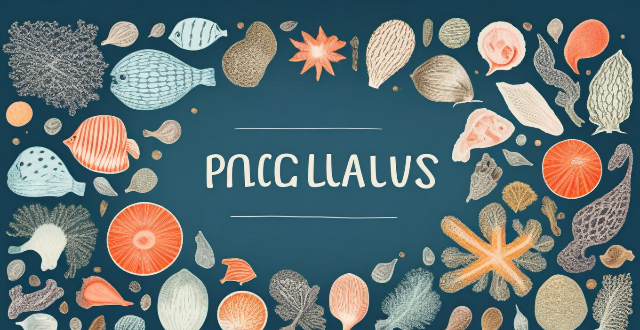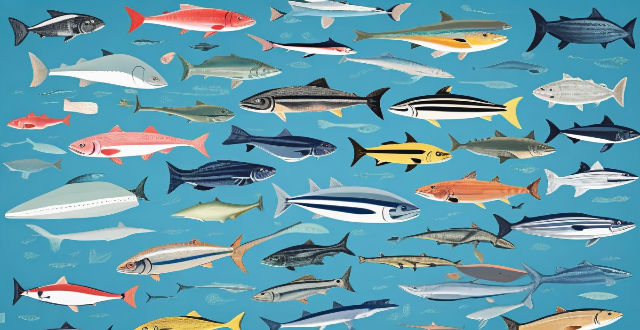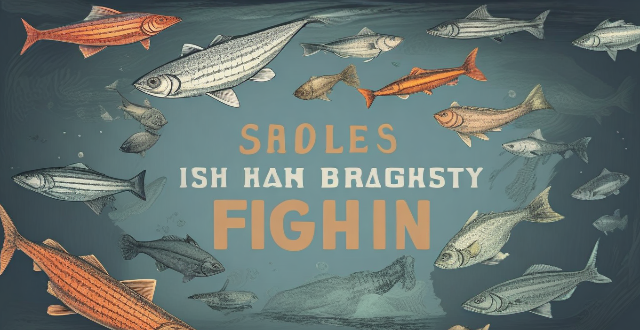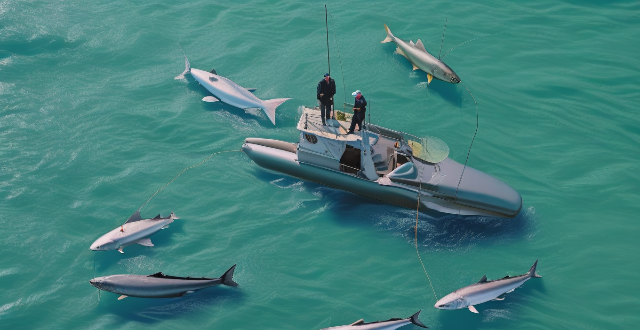De Fish

What are some tips for pan-searing a fillet of fish ?
The article provides a comprehensive guide on how to pan-sear a fillet of fish. It emphasizes the importance of choosing the right type of fish, seasoning it well, using the right cooking equipment, and following specific steps for optimal results. The tips include dry-seasoning the fish, adding enough oil to the pan, flipping the fish carefully, and allowing it to rest before serving.

How do I prepare a perfect grilled fish ?
Grilling fish is a delightful culinary experience that can be perfected with the right preparation and process. Here's a step-by-step guide to help you achieve perfection every time you fire up the grill for your favorite fish: 1. **Preparation** - **Choosing the Right Fish**: Opt for fresh fish, aim for fillets that are at least 1-inch thick, and choose types of fish like salmon, sea bass, and swordfish that are great for grilling due to their natural fat content. - **Marination**: Decide on the flavor profile you want, marinate the fish for at least 30 minutes to an hour in the refrigerator, but be cautious not to leave it too long as the acid in the marinade can start to cook the fish. - **Grill Prep**: Ensure your grill is clean to avoid any unwanted flavors and lightly oil the grates to prevent sticking. 2. **Grilling Process** - **Preheating the Grill**: Preheat the grill to medium-high heat, ideal temperature range between 375°F to 450°F (190°C to 230°C). - **Cooking the Fish**: Place the fish skin side down on the grill, flip the fish only once, and use a wide spatula to carefully flip and remove the fish without breaking it. - **Checking for Doneness**: The flesh should turn from translucent to opaque and give a gentle poke; it should flake easily with a fork. 3. **Serving Suggestions** - **Lemon Wedges**: Serve with wedges of lemon to add a fresh citrus note. - **Herb Sauce**: Pair with a simple herb sauce or compound butter. - **Side Dishes**: Consider serving with grilled vegetables, a fresh salad, or roasted potatoes. By following these steps, you will be able to prepare a perfect grilled fish that is sure to impress your guests or simply satisfy your own cravings for a delicious meal. Enjoy the process and savor the flavor!

What kind of seasonings work well with different types of fish ?
This text provides a comprehensive guide to seasonings for various types of fish and shellfish, categorized by freshwater and saltwater species. It offers specific seasoning suggestions for each type of fish or shellfish, such as salmon, trout, catfish, tuna, mahi-mahi, sardines, anchovies, shrimp, lobster, crab, clams, mussels, and oysters. The suggested seasonings aim to enhance the natural flavors of the seafood while adding depth and complexity to the dishes.

How do changing ocean temperatures influence fish migration patterns ?
This article explores how changing ocean temperatures influence fish migration patterns, affecting fish populations and the fishing industry. Water temperature plays a crucial role in fish metabolism, growth rates, reproduction, and survival, making it essential to understand its impact on migration patterns. Changing ocean temperatures can alter habitat conditions, food availability, cause physiological stress, and affect reproduction, leading to decreased abundance, shifting fishing grounds, economic losses, and ecosystem disruption. Monitoring ocean temperatures and adapting fishing practices are crucial for managing fish populations sustainably and mitigating the negative impacts of climate change on marine ecosystems.

Is it safe to eat raw fish like sushi and ceviche at home ?
The text delves into the safety concerns of consuming raw fish at home, highlighting potential risks such as foodborne illnesses and toxin exposure. It then provides guidelines on selecting, handling, and preparing raw fish to minimize these risks. Despite these precautions, it emphasizes that complete risk elimination is impossible and advises enjoying raw fish responsibly.

How is ocean acidification due to carbon dioxide absorption affecting the health of fish stocks ?
**Ocean Acidification and Its Impact on Fish Stocks** The absorption of carbon dioxide (CO2) from the atmosphere into the ocean causes ocean acidification, leading to a decrease in pH levels and increased acidity. This phenomenon poses significant threats to marine life, particularly fish stocks, through various effects: 1. **Changes in Calcium Carbonate Availability:** As the ocean becomes more acidic, there is less calcium carbonate available for shell formation in many fish species, affecting their growth and survival, especially during early developmental stages. 2. **Altered Food Web Dynamics:** Acidification can cause changes in plankton communities, disrupting the food chain and affecting predator-prey relationships, potentially leading to overpredation or starvation among certain fish species. 3. **Behavioral Changes:** Increased acidity can interfere with sensory systems in fish, affecting their ability to find food, avoid predators, and navigate. It may also alter reproductive behavior, leading to reduced breeding success. 4. **Energy Allocation:** Acidification increases metabolic costs associated with maintaining physiological functions, reducing resources available for growth, reproduction, and other essential processes. It can also weaken the immune system, making fish more susceptible to diseases and parasites. Understanding these effects is crucial for developing strategies to mitigate the impacts of ocean acidification and protect marine ecosystems.

What role do climate models play in predicting future fishery yields ?
Climate models are essential for predicting future fishery yields by analyzing ocean conditions, projecting changes in fish population dynamics, and evaluating potential impacts on management strategies. They help identify shifts in habitats, migration patterns, growth rates, recruitment success, mortality rates, fishing quotas, spatial management needs, and diversification opportunities. This knowledge aids in developing resilient and adaptive approaches to ensure the long-term sustainability of fisheries resources amidst climate change.

How does climate change affect the fishing industry ?
Climate change affects the fishing industry through changes in water temperature, ocean acidification, extreme weather events, changes in fisheries management policies, and economic impacts. These factors can lead to overfishing, reduced fish populations, damage to infrastructure and equipment, disruption of natural habitats, and decreased profitability for fishermen. To address these challenges, sustainable management practices and international cooperation are necessary to ensure the long-term viability of the fishing industry.

What are the impacts of global warming on marine life and fish populations ?
The provided text discusses the impacts of global warming on marine life, particularly fish populations. It outlines how rising ocean temperatures alter habitats and affect metabolic rates; how ocean acidification disrupts calcification processes; how changes in currents and water circulation alter migration patterns and species ranges; the loss of coral reefs and its implications; the effects of extreme weather events on marine environments; and the challenges these changes present for resource management. The conclusion emphasizes the need for collective efforts to mitigate the effects of global warming on oceans.

What are the most popular food tours in major cities ?
Food tours have become a popular way for travelers to explore the culinary delights of major cities around the world, offering an immersive experience that allows visitors to taste local specialties and learn about the history and culture behind each dish. The most popular food tours in major cities include Chinatown, Little Italy, and Greenwich Village in New York City; Montmartre, Marais District, and Saint-Germain-des-Prés in Paris; Tsukiji Fish Market, Shinjuku, and Asakusa in Tokyo; Trastevere, Testaccio, and Campo de' Fiori in Rome; Singapore Heritage, Night Safari, and Orchard Road in Singapore; La Boqueria Market, Gràcia District, and El Born District in Barcelona. These food tours offer a delicious way to explore the cultural diversity and culinary traditions of major cities around the world.

What are the best techniques for cooking seafood ?
The article provides a summary of the best techniques for cooking seafood, which include poaching, grilling, steaming, and baking. Poaching is a gentle method of cooking seafood in a flavorful liquid such as water, broth or wine. Grilling is ideal for firm-fleshed fish like salmon or swordfish and adds flavor and texture to seafood. Steaming is a healthy way to cook seafood without adding extra fat and works well for fish fillets or shellfish like clams or mussels. Baking is a dry heat method that works well for thicker cuts of fish like cod or haddock. The article emphasizes the importance of paying attention to timing and temperature to avoid overcooking seafood.

How do I make sushi at home ?
Sushi is a popular Japanese dish that has gained worldwide popularity for its delicious taste and health benefits. Making sushi at home can be a fun and rewarding experience. Here are the steps to follow: Ingredients: - Sushi rice - Nori sheets - Fish fillets (salmon, tuna, or any other fish of your choice) - Vegetables (cucumber, avocado, carrots) - Soy sauce - Wasabi - Pickled ginger Tools: - Bamboo sushi mat - Rice cooker or pot - Sharp knife Steps: 1. Cook the sushi rice by rinsing it in cold water until the water runs clear, then cooking it with water in a pot until all the water has been absorbed. Mix the cooked rice with sushi vinegar using a wooden spoon. 2. Prepare the fish and vegetables by cutting them into thin slices and long, thin strips respectively. 3. Assemble the sushi rolls by placing a sheet of nori on top of the bamboo sushi mat, spreading a small handful of sushi rice evenly over the nori sheet leaving about an inch gap at the top, arranging the fish and vegetable slices on top of the rice, and rolling the sushi tightly using the bamboo mat. Wet the gap at the top of the nori sheet with water to seal the roll. 4. Cut the sushi rolls into bite-sized pieces using a sharp knife, wiping the knife with a damp cloth between each cut to prevent sticking. 5. Serve the sushi by arranging the pieces on a plate and serving with soy sauce, wasabi, and pickled ginger. Enjoy your homemade sushi!

Are there any international agreements or policies addressing the interplay between climate change and the conservation of fisheries ?
The interconnected issues of climate change and fisheries conservation are addressed through various international agreements and policies. The UNFCCC aims to stabilize greenhouse gas concentrations, indirectly supporting fisheries conservation. UNCLOS provides a legal framework for ocean governance and resource management, promoting cooperation in managing fish stocks. The CBD focuses on biodiversity conservation and sustainable use of resources, acknowledging the impacts of climate change on ecosystems vital for fisheries. RFMOs manage fisheries in specific regions, incorporating climate change considerations into their strategies. National policies integrate climate action with fisheries conservation measures. Together, these frameworks work towards sustainable management of climate change and fisheries conservation.

Can you suggest any food markets that should not be missed when traveling ?
Food markets around the world offer a window into local culture and cuisine. Here are some must-visit food markets: 1\. Boqueria Market, Barcelona, Spain: Known for its fresh produce, seafood, and tapas bars. 2\. Grand Bazaar, Istanbul, Turkey: Offers Turkish delights, spices, and sweets. 3\. La Boqueria, Mexico City, Mexico: A feast for the senses with vibrant colors and aromatic smells. 4\. Kreta Ayer Wet Market, Singapore: Located in Chinatown and known for live seafood and Chinese herbs. 5\. Tsukiji Fish Market, Tokyo, Japan: Renowned for its early morning tuna auctions and seafood. 6\. Mercado de San Miguel, Madrid, Spain: Housed in a historic building with gourmet tapas and wines. 7\. Jemaa el-Fnaa Market, Marrakech, Morocco: A night market surrounded by food stalls offering Moroccan cuisine. 8\. Pike Place Market, Seattle, USA: Known for its fresh produce, artisanal foods, and local crafts. 9\. Queen Victoria Market, Melbourne, Australia: Offers a mix of fresh produce, gourmet foods, and international cuisine. 10\. Or Tor Kor Market, Bangkok, Thailand: Known for its fresh produce, street food, and local ingredients. These markets provide not only delicious food but also a chance to immerse oneself in the local culture.

What is the relationship between biodiversity and traditional knowledge ?
The text discusses the complex interrelationship between biodiversity and traditional knowledge, highlighting how each influences and shapes the other in various ways. It explains that communities living in diverse ecosystems develop unique practices adapted to their surroundings, such as specific crop rotations or intercropping methods suited to local biodiversity. The availability of certain species also influences dietary habits, with coastal communities relying heavily on seafood while inland communities depend more on terrestrial resources. Furthermore, high biodiversity regions often lead to extensive knowledge about medicinal plants, with Indigenous communities having long histories of using local flora for healing. The need for sustainable harvesting of these plants can lead to traditional conservation practices like rotating harvest areas or planting more of certain species to ensure their survival. On the other hand, traditional knowledge often includes practices for managing resources sustainably, such as fishing techniques that do not deplete fish populations or agricultural methods that maintain soil fertility. In many cultures, certain areas are considered sacred and are protected from exploitation, serving as de facto conservation reserves. However, as biodiversity declines, so does the traditional knowledge associated with it. The loss of certain species can lead to the disappearance of associated cultural practices and knowledge. With diminished biodiversity, traditional knowledge becomes less effective, leaving communities vulnerable to ecological shifts. In conclusion, the relationship between biodiversity and traditional knowledge is one of mutual dependence and influence. While biodiversity shapes the development of traditional knowledge, this knowledge also plays a critical role in maintaining and conserving biodiversity. Preserving both is essential for the well-being of our planet and its people.

Can you suggest popular dishes that showcase genuine Mexican flavors ?
Mexico's vibrant cuisine blends indigenous ingredients and Spanish cooking techniques. Popular dishes include a variety of tacos, enchiladas, chiles rellenos, quesadillas, authentic soups and broths, antojitos (snacks), street food, and beverages like horchata and agua fresca. These dishes showcase genuine Mexican flavors and the country's rich culinary heritage.

What are the most popular festive foods around the world ?
The text discusses a variety of festive foods from different cultures around the world, including Christmas, Easter, Hanukkah, Eid al-Fitr, Diwali, Chinese New Year, and Halloween. Each section highlights traditional dishes associated with these holidays and their cultural significance, such as Turkey and Pumpkin Pie for Thanksgiving and Christmas in the United States, La Vigilia and Panettone in Italy, and Kabsa and Maamoul in Saudi Arabia. The text emphasizes how these foods bring people together, symbolize tradition, and create a sense of joy and community during celebrations.

Are there any celebrity-owned or frequented high-end restaurants I should try ?
If you're looking for a high-end dining experience with a celebrity touch, several restaurants owned by or frequented by celebrities are worth trying. Here are some of the top options: 1\. **Nobu Malibu**: Located in Malibu, California, and owned by Robert De Niro, Nobu Malibu offers stunning views of the Pacific Ocean and signature dishes like Black Cod with Miso and Yellowtail Sashimi with Jalapeño. 2\. **Giorgio Baldi**: Known for its romantic atmosphere and delicious Italian cuisine, Giorgio Baldi in Santa Monica, California, is formerly owned by George Clooney. Must-try dishes include the Lobster Ravioli and the Branzino al Salmoriglio. 3\. **The Polo Lounge**: The Polo Lounge at the Beverly Hills Hotel is a classic Hollywood haunt where you can enjoy traditional American fare while keeping an eye out for A-listers. Don't miss the signature McCarthy Salad and the Prime Rib. 4\. **Mr. Chow**: Mr. Chow is a legendary Chinese restaurant chain that has been a favorite among celebrities for decades. The menu features upscale Chinese cuisine, including Peking Duck and XO King Prawns. 5\. **TAO Downtown**: TAO Downtown is a vibrant nightlife destination that also serves upscale Asian fusion cuisine. The menu includes sushi, dim sum, and larger plates like Whole Lobster with Truffle Ginger Sauce. 6\. **Madeo**: Madeo is a chic Italian restaurant that attracts a celebrity crowd with its modern Italian cuisine and trendy atmosphere. Dishes like the Cacio e Pepe and the Branzino Al Forno are standouts on the menu. 7\. **Catch LA**: Catch LA is a seafood restaurant and rooftop bar that has become a celebrity magnet thanks to its delicious food and lively atmosphere. Must-try dishes include the Yellowtail Snapper Crudo and the Lobster Newburg. 8\. **Spago Beverly Hills**: Owned by celebrity chef Wolfgang Puck, Spago Beverly Hills is known for its innovative Californian cuisine. The menu features seasonal dishes like Roasted Chicken with Morel Mushrooms and Artichokes Barigoule. 9\. **Chiltern Firehouse**: Chiltern Firehouse is a members-only club that has become a favorite among celebrities like Emma Watson and Kate Moss. The menu features upscale British cuisine, including dishes like Beef Wellington and Fish and Chips. 10\. **The Ivy**: The Ivy in Los Angeles is a legendary spot for celebrity sightings and power lunches. The menu offers classic American fare like Crab Cakes and Grilled NY Steak.

Where can I find the best French patisserie in Paris ?
Paris is renowned for its delectable pastries and desserts, and finding the best French patisserie can be a delightful adventure. Some of the top recommendations include Angelina, Ladurée, Pierre Hermé, Du Pain et des Idées, Pâtisserie Ciel, Gerard Mulot, Arnaud Larher, Carl Marletti, Patrick Roger, Hugo & Victor, L'Éclair de Génie, Le Moulin de la Vierge, Gosselin, and Au P'tit Suisse. Each offers their own unique twist on the classic French pastry, from traditional macarons to modern flavor combinations.

What are some traditional French desserts served during the Christmas holiday season ?
The Christmas holiday season in France is a time for indulgence, and what better way to indulge than with delicious desserts? Here are some traditional French desserts that are often served during the festive season: 1. Bûche de Noël (Yule Log) - A classic French Christmas dessert, this rolled sponge cake is filled with creamy chocolate buttercream and decorated to resemble a log. 2. Tarte de Pommes Caramélisées (Caramelized Apple Tart) - Thinly sliced apples are caramelized and arranged in a pastry shell, creating a smooth and rich custard filling. 3. Palets Breton (Breton Butter Biscuits) - Light and crispy butter biscuits from the Brittany region of France, often served alongside coffee or tea. 4. Macarons - Although not exclusively a Christmas dessert, macarons are a staple in French patisseries all year round. Festive flavors like gingerbread, peppermint, and chestnut make them perfect for the holiday season. 5. Buche de Châtaignes (Chestnut Log) - Similar to the Bûche de Noël, this chestnut-flavored sponge cake is rolled up with chestnut cream and decorated with marzipan to resemble a bark. 6. Oeillet Parfait (Parfait Pudding) - A light and airy pudding made with whipped cream and flavored with vanilla or other extracts, often served in individual glasses and topped with fresh fruit or berries. These traditional French desserts add a touch of elegance and sophistication to any Christmas celebration, satisfying every sweet tooth!

What are the best museums in South America to learn about local history and culture ?
South America is home to fascinating museums showcasing the region's history and culture. The **Museo del Oro** in Bogotá, Colombia, features pre-Columbian gold artifacts, while the **Museo Histórico Nacional** in Santiago, Chile, offers a broad overview of Chilean history. The **Museu Histórico Nacional** in Rio de Janeiro focuses on Brazil's imperial past, and the **Museo de la Memoria** in Santiago confronts Chile's military dictatorship. Finally, the **Museo de Arte Precolombino** in Lima showcases the artistic achievements of ancient Peruvian civilizations. Each museum provides unique insights into South American history and culture.